Tong W. Wind Power Generation and Wind Turbine Design
Подождите немного. Документ загружается.

CHAPTER 18
Power curves for wind turbines
Patrick Milan , Matthias Wächter , Stephan Barth & Joachim Peinke
ForWind Center for Wind Energy Research of the Universities
of Oldenburg, Bremen and Hannover, Oldenburg, Germany.
The concept of a power curve is introduced, as well as the principles of the power
conversion performed by a wind turbine. As an appropriate approach for the
estimation of the annual power production of a wind turbine, the procedure to
determine the power curve after the international standard IEC 61400 of the Inter-
national Electrotechnical Commission (IEC) is discussed. As another approach
is introduced a stochastic defi nition of a power curve which is based on high fre-
quency measurement data and on the dynamic response of the wind turbine to
wind fl uctuations. The latter approach should be seen as a completion to the IEC
defi nition which provides further insight into the dynamic performance of a wind
turbine and may be used as a monitoring tool for wind turbines.
1 Introduction
The overall purpose of a wind turbine is to produce electrical power from wind.
Quantifying this power output is necessary, on the one hand, for the fi nancial plan-
ning of any wind energy project. On the other hand, besides the pure amount of
energy production, also the dynamics of the power conversion contains essential
information about, e.g. mechanical and electrical performance of the turbine and
power quality. Following the turbulent behavior of the wind, the power produc-
tion of a wind turbine fl uctuates on short-time scales [ 1 ]. While exploiting the
free, uncontrolled input that is the wind, it is of primary importance to control
the stability of the power output of wind turbines. A large integration into energy
networks supposes a good command of the power production, in terms of quantity,
quality and availability.
To achieve such control, it is necessary to understand the behavior of wind turbines
and quantify it. This is the scope of power performance techniques. This chapter
596 Wind Power Generation and Wind Turbine Design
introduces such methods, so as to estimate the performance of a wind turbine. The
procedure applies to single wind turbines, while ongoing developments lead
towards integration of entire wind parks, and possibly large networks.
The approach is restricted to large-scale horizontal-axis wind turbines here. It
is also assumed that the produced electrical energy is directly fed into the grid.
This is not an essential restriction but facilitates putting the presented work in a
relevant context. For a detailed overview of different types of wind turbines and
corresponding modes of operation see, e.g. [ 2 ].
2 P ower performance of wind turbines
2.1 Introduction to power performance
In the past 30 years, recommendations and standards were defi ned to determine
the power performance of a wind turbine. Permanently developed, the International
Electrotechnical Commission (IEC) set the international standard IEC 61400-12 and
its revised version IEC 61400-12-1 in 2005 [ 3 ]. These common guidelines defi ned
the power performance characteristic of a wind turbine by the so-called power curve
and its corresponding estimated annual energy production (AEP). The IEC standard
gives a good estimation of long-time power production (through the AEP), which is
of primary importance for an economical approach to wind energy.
Regarding actual power performance, the power curve is a powerful tool to
estimate the power extraction process, as it quantifi es the relation between incom-
ing wind and power output of a wind turbine. Simultaneous measurements of wind
speed u ( t ) and power output P ( t ) must be performed for the wind turbine con-
cerned. Here the power output P ( t ) is the net power released by the wind turbine
into the electrical grid. From this data collection, a functional relation P ( u ) can be
defi ned, and a two-dimensional curve of power output vs. incoming wind speed can
be derived. This is what power performance refers to. Such procedure can then be
applied on single wind turbines in order to characterize their power performance,
monitor their behavior over time as well as predict their power production. While
this prediction is well described by the IEC defi nition of AEP, monitoring methods
can be defi ned based on a dynamical approach to wind energy conversion.
In order to test power performance, a measurement of the wind velocity must be
performed. As a wind turbine distorts the incoming wind fi eld, a measurement in
the rotor plane or closeby is not useful, at least not without further corrections.
Instead the incoming upstream velocity is generally chosen as representative of the
wind fi eld, and measured from a meteorological mast at turbine hub height, a cer-
tain distance in front of the turbine. Based on these considerations, it becomes
possible to quantify the power performance of a wind turbine in simple ways.
2.2 Theoretical considerations
The purpose of this section is to give a simple understanding of fl uid mechanics
applied to wind turbines. A detailed description of the formulas and derivations
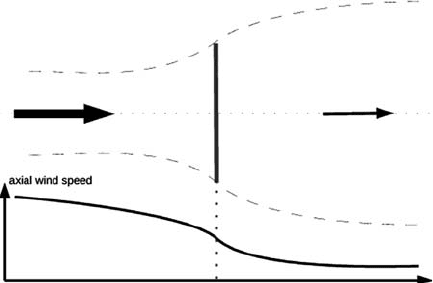
Power Curves for Wind Turbines 597
presented here can be found in [ 2 ]. This theoretical approach sets ground for the
further power curve analysis.
In the following derivation, the complexity of turbulence will be set aside so as
to understand the fundamental behavior of a wind turbine. Atmospheric wind has
fi nite time and space structures, more commonly referred to as turbulent struc-
tures. Its statistics display complex properties like unstationarity or intermittency
(such as gusts), whose effects will not be discussed in this section. They repre-
sent active research topics whose detailed analysis is outside the scope of this
introduction, cf. [ 4 ]. In this section, a uniform fl ow at steady-state is considered.
Based on the fact that a wind turbine converts the wind power into available
electrical power, one can assume the following relation:
pwind
() () ()Pu c uP u=
(1)
where P
wind
( u ) is the power contained in the wind passing with speed u through
the wind turbine, and P ( u ) is the electrical power extracted. The power coeffi cient
c
p
( u ) represents the amount of power converted by the wind turbine. Because the
input P
wind
( u ) cannot be controlled, improvements in wind power performance
involve increasing the power coeffi cient c
p
( u ). Momentum theory can now be
applied to determine this coeffi cient.
Consider a volume of air moving towards the wind turbine, which is modeled as
an actuator disc of diameter D . A stream-tube is defi ned here as the volume of air
that interacts with the turbine (see Fig. 1 ). The wind is affected by the wind turbine
when crossing its swept area as the turbine extracts part of its energy. The extrac-
tion of kinetic energy accounts for a drop in the wind speed from upstream to
downstream, as shown in Fig. 1 . To ensure mass conservation, the stream-tube has
to expand in area downstream, as shown in Fig. 1 [ 2 ].
Following this simple analysis, one can estimate the amount of kinetic energy
available for extraction. The wind power P
wind
( u ) is derived from momentum
theory for the wind passing with speed u through the rotor of area p D ²/4:
Figure 1 : A visual representation of an airfl ow on a wind turbine. The stream-tube is
affected by the presence of the wind turbine that extracts part of its energy.
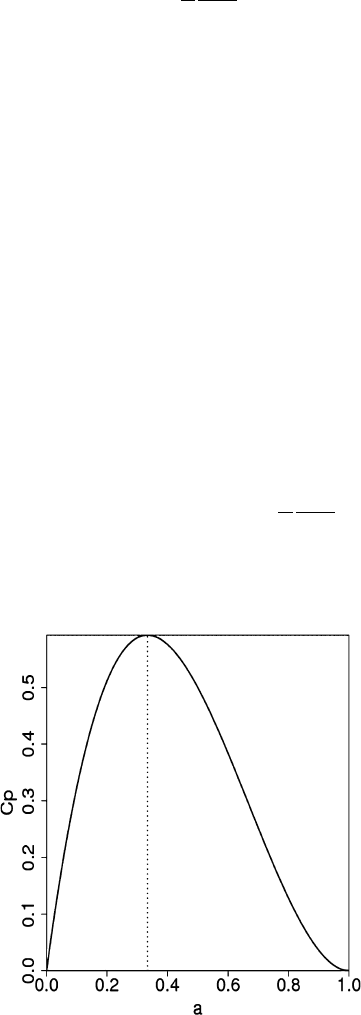
598 Wind Power Generation and Wind Turbine Design
2
3
wind
()
24
D
Pu u
rp
=
( 2)
where r is the air density.
This stream-tube expansion shows that c
p
( u ) has a physical limit called Betz
limit such that c
p
( u ) ≤ 16/27 ≈ 0.593 [ 2 , 5 ]. Regardless of its design, a wind turbine
can thus extract at most 59.3% of the wind energy. Figure 2 shows the power coef-
fi cient as a function of a = (1 − u
downstream
/ u
upstream
), the axial fl ow induction factor
a gives the ratio of speed lost by the wind. The Betz limit corresponds to the
maximum power a wind turbine can extract, when a = 1/3 [ 2 ]. This result is
obtained for an actuator disc. The more complex shape of a real wind turbine cer-
tainly brings a lower limit for c
p
. This physical limit is due to the stream-tube
expansion induced by the presence of the turbine, i.e. by distorting the wind fi eld,
a wind turbine sets a limit for the energy availability. Criticism of this approach is
given in [ 6 , 7 ], leading to a less well defi ned upper limit of c
p
.
Although it is based on a simplifi ed approach, the Betz limit is a widely used
and accepted value. The power coeffi cients of modern commercial wind turbines
reach values of 0.45 and more. Physical aspects that limit the value of the power
coeffi cient are, e.g. the fi nite number of blades and losses due to the drag and stall
effects of the blades [ 2 , 8 ].
Joining eqns ( 1 ) and ( 2 ), the theoretical power curve reads
2
3
theoretical p wind p
() () () ()
24
D
P u cuP u cu u
rp
==
(3 )
P
theoretical
( u ), or more simply P ( u ) is the electrical power output and u is the input
wind speed ( u
upstream
), i.e. a power curve is roughly characterized by a cubic
Figure 2: Power coeffi cient c
p
as a function of the axial fl ow induction factor a .
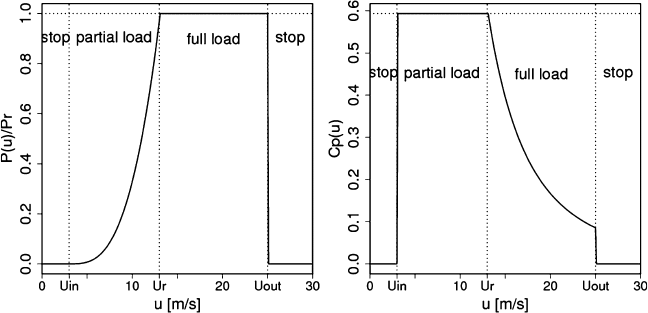
Power Curves for Wind Turbines 599
increase of the power output with the wind speed. The functional behavior of the
power coeffi cient c
p
( u ) is the result of certain control strategies as well as of Betz
physical limit.
In the mechanical power extraction the usual way to control power production
is achieved by stall effects on the rotor blades. Stall effects happen when the criti-
cal angle of attack for an airfoil is exceeded, resulting in a sudden reduction in the
lift forces generated by the airfoil. In modern wind turbines this is achieved by
so-called active stall control or pitch control [ 2 ]. This consists of a rotation of the
blades into the plane of rotation and the blade cross-section. The blade rotation
angle is known as blade pitch angle q . The power coeffi cient c
p
is in this case a
function of the blade pitch angle q and the tip-speed ratio l = w R / u (where w is the
angular velocity of the rotor, R the rotor radius, i.e. blade length and u the wind
speed), i.e. c
p
= c
p
[ l ( u ), q ]. Thus, the power extraction of wind turbines is opti-
mized via c
p
[ l ( u ), q ] to a desired power production. In particular for high wind
conditions c
p
is lowered to protect the turbine machinery and avoid overshoots in
power production.
To achieve an effi cient pitch control during wind energy conversion the
wind turbine is equipped by a power controller system. This is generally com-
posed of several composite mechanical–electrical components that, depending
on the type of design, operate actively for the optimum power performance.
As a consequence the power output operation for active stall wind turbine
systems can be separated into two states: partial load, with maximum c
p
value,
and full load, with reduced c
p
values. A complete detail of the overall structure
of the power operation system for different wind turbine types is described
in [ 2 ]. Numerical wind turbine simulation can be found, e.g. in [ 9 ]. The theo-
retical power curve P ( u ) together with the corresponding c
p
( u ) is represented
in Fig. 3 .
Figure 3 : LEFT: Static (steady-state) power curve P ( u ) of an active stall controlled
wind turbine showing the different power operation states: stop, partial
and full load. RIGHT: Corresponding power coeffi cient c
p
( u ).
600 Wind Power Generation and Wind Turbine Design
In partial load u > u
cutin
, where u
cutin
is the minimum wind speed for power pro-
duction, the wind turbine yields the maximum wind energy extraction by power
optimization operation. This is achieved by an effective power control system
which adjusts to the desired pitch angle q , at a given wind speed u , in order to
optimize the power coeffi cient c
p
( u ) and hence the power production. In practice a
simple lookup table is the most used method for this operation [ 9 ]. The partial load
area of the power curve is limited to the range u
cutin
< u < u
r
where u
r
is the rated
wind speed.
In full load u
r
< u < u
cutout
, where u
cutout
is the maximum wind speed (or shut-
down wind speed) for power production, the wind turbine power output is limited
to nominal or rated power. In this power setting typically the pitch angle q is
adjusted to control the power output to its rated power value P
r
.
For u > u
cutout
the pitch angle q is maximized (minimizing the angle of attack) to
the feathered position in order to eliminate the lift forces on the rotor blades. As a
consequence power generation is switched off (stopped).
The main properties of wind turbine power curves have been introduced so
far. However, the theoretical power curve is derived from a laminar wind fl ow,
which never occurs in real situations. The complexity of the wind, i.e. the turbu-
lence needs more complex models to analyze power performance. Following the
path of turbulence research, statistical models to deal with complexity will now
be introduced.
2.3 Standard power curves
The power performance procedure for wind turbines defi ned by the IEC in 2005,
and labeled IEC 61400-12-1 is now introduced. For a detailed description of the
procedure, please refer to the complete proceeding [ 3 ]. This procedure provides a
common methodology to ensure consistency, accuracy and reproducibility in the
measurement and the analysis of power performance of wind turbines. It consists
of the minimum requirements for a power performance test, as well as a procedure
to analyze the measured data that can be applied without extensive knowledge.
The standard procedure fi rst describes the necessary preparations for the perfor-
mance test, such as criteria for the test equipments, guidance for the location and
setup of the meteorological mast that will be used to measure the wind speed and
other parameters like the wind direction, the temperature and the air pressure. The
measurement sector is also described, as the range of wind directions that are valid
for a representative measurement. Wind directions in the wake of the wind turbine
must be excluded. A more detailed assessment of the terrain at the test site is pro-
vided in the optional site calibration procedure that reports for additional obstacles
in addition to the wind turbine itself. The measurement procedure must be per-
formed for the different variables, so that the data collection displays a suffi cient
quantity and quality to estimate accurately the power performance characteristics
of the wind turbine.
The measured data is then averaged over periods of 10 min. These averaged
values are used for the analysis, together with their corresponding standard errors
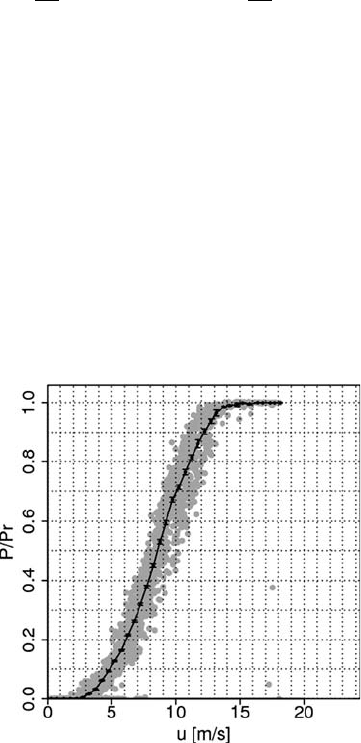
Power Curves for Wind Turbines 601
(based on the standard deviations). A normalization must then be applied to the
measurement data. Depending on the type of turbine, either the means of wind speed
(for turbines with active power control) or of power output (for stall-regulated
turbines) must be normalized to a reference air density.
The IEC power curve is then derived from the normalized values using the
so-called method of bins, i.e. the data is split into wind speed intervals of a width
of 0.5 m/s each. For each interval i , bin averages of wind speed u
i
and power output
P
i
are calculated according to
norm, , norm, ,
11
11
and
ii
NN
iijiij
ii
ii
uu PP
NN
==
==
∑∑
( 4)
where u
norm, i , j
and P
norm, i , j
are the normalized values of wind speed and power aver-
aged over 10 min, and N
i
is the number of 10 min data sets in the i th bin.
For the power curve to be complete, or reliable, each bin must include at least
30 min of sampled data and the entire measurement must cover a minimum period
of 180 h of data sampling. The range of wind speeds shall extend from 1 m/s below
cutin wind speed to 1.5 times the wind speed at 85% of the rated power P
r
of the
wind turbine. Such power curve was represented in Fig. 4 for a multi-MW wind
turbine. Error bars were included following the recommendations below.
The standard also provides a description of the evaluation of uncertainty in the
power performance measurement [ 3 ]. In a fi rst step, the respective uncertainties
are obtained from the measurement as the standard error of the normalized power
data. Additional uncertainties are related to the instruments, the data acquisition
system and the surrounding terrain.
Figure 4 : Power curve (line) obtained from the IEC standard procedure for a
multi-MW wind turbine. Corresponding error bars were displayed. The
grey dots represent 10-min averages. The power output is normalized
by its rated value P
r
.
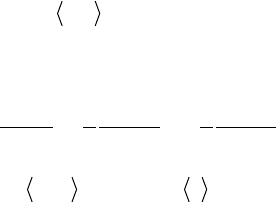
602 Wind Power Generation and Wind Turbine Design
Based on the IEC procedure, the AEP can be derived by integrating the mea-
sured power curve to a reference distribution of wind speed for the test site, assum-
ing a given availability of the wind turbine [ 3 ]. The AEP is a central feature for
economical considerations.
The standard procedure defi ned by the IEC offers some interesting insights. It is
a great advance as it sets a common ground for wind power performance. As the
wind industry develops, common standards help building a general understanding
between manufacturers, scientists and end-users. The IEC procedure serves this
purpose as the most widely used method to estimate power performance.
A detailed analysis of this standard is of great importance for anyone who
wishes to test power performance. The procedure defi nes a set of important param-
eters, such as the wind direction, terrain corrections and requirements for wind
speed measurements. These parameters are relevant for performance measure-
ments, regardless of the fi nal method used to handle data. The main strength of the
method lies in the defi nition of these important parameters.
Unfortunately, the standard procedure presents important limits. In contrast to a
good defi nition of the requirements above, the way the measured data is analyzed
suffers mathematical imperfections. In order to deal with the complexity of the
conversion process, the data is systematically averaged. A statistical averaging is
indeed necessary to extract the main features of the complex process, and the cen-
tral question is how to perform this averaging. The IEC method applies the averag-
ing over 10-min intervals, which lack physical meaning. The wind fl uctuates on various
time scales, down to seconds (and less). A systematic averaging over such time scales
as 10 min neglects all high frequency fl uctuations present in the wind dynamics, but
also in the dynamics of the extraction process. In combination with the fundamental
non-linearity characteristics of the power curve, i.e. P ( u ) ∝ u
3
, the resulting power
curve is spoiled by mathematical errors, as derived below [see eqn ( 7 )].
One can split the wind speed u ( t ) into its mean value and the fl uctuations around
this mean value:
() () () ().ut ut vt V vt=+=+
( 5)
where 〈 u ( t ) 〉 represents the average (arithmetic mean) value of u ( t ). Applying a
Taylor expansion to P ( u ) gives [ 10 ]:
23
234
23
() 1 () 1 ()
() ( ) ( )
26
PV PV PV
Pu PV v v v ov
u
uu
∂∂ ∂
=+ + + +
∂
∂∂
(6 )
(
)
() ( )Pu PV P u≠=
( 7)
It appears that the average of the power is not the power of the average, due to the
non-linear relation P ( u ) ∝ u
3
and the high frequency turbulent fl uctuations. The
IEC procedure gives P ( V ) exactly P ( 〈〈 u ( t ) 〉
10min
〉
bin
), which neglects the high-order
terms in the Taylor expansion. The resulting IEC power curve should be corrected
by the second- and third-order terms.
As a consequence of this mathematical over-simplifi cation, the result depends
on the turbulence intensity I = s / V (where s ² = 〈 u ²( t ) 〉) and on the wind condition
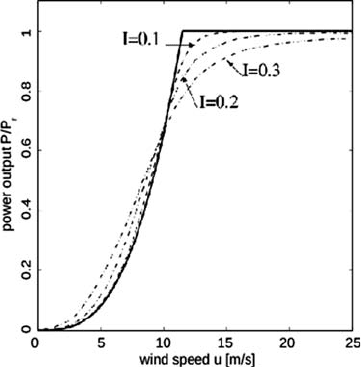
Power Curves for Wind Turbines 603
during the measurement [ 10 ]. Figure 5 illustrates this mathematical limit. The IEC
power curve fails to characterize the wind turbine only, as the fi nal result also
depends on the wind condition during the measurement. For this reason, the IEC
procedure cannot be fully satisfactory as a power performance procedure. The
requirements for a measurement of power performance are well defi ned, but it is
necessary to introduce a new method to process the measured data u ( t ) and P ( t ).
2.4 Dynamical or Langevin power curve
The averaging procedures within the IEC standard [ 3 ] induce the problem of sys-
tematic errors because of the non-linear dependence of the power P on the wind
speed u in a wide range of u . Thus the standard power curve will depend not
only on the characteristics of a turbine, but also on the wind situation, and on
the conversion dynamics of a turbine. On the other hand, if no averaging is per-
formed, the power conversion is discovered to be a highly dynamical system even
on very short-time scales, as it can be seen in Fig. 6 . Recently it could be shown
that the statistics of the electrical power output of a wind turbine is close to the
intermittent, non-Gaussian statistics of the wind speed [ 1 ].
2.4.1 Obtaining the Langevin power curve
To derive the power characteristic of a wind turbine from high-frequency measure-
ments without the use of temporal averaging, one can regard the power conver-
sion as a relaxation process which is driven by the turbulently fl uctuating wind
Figure 5 : The effects of non-linearity of the power curve for turbulence intensities
I = 0.1, 0.2, 0.3. The full line is the theoretical power curve P ( u ) and the
dotted line is the standard power curve given by the IEC procedure. The
data has been obtained from numerical model simulations [ 10 ].
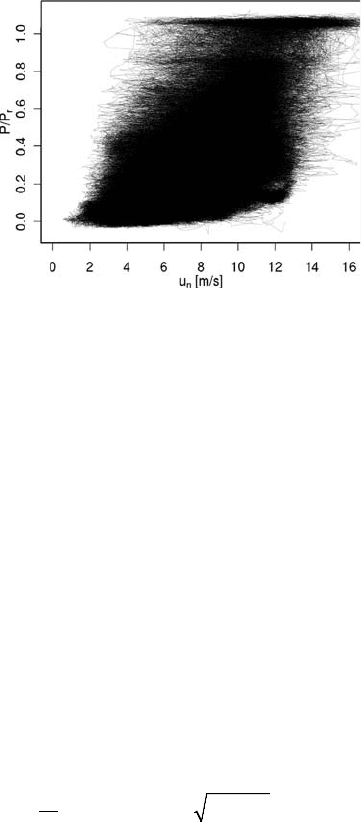
604 Wind Power Generation and Wind Turbine Design
speed, see also [ 13 , 14 ]. For the (hypothetical) case of a constant wind speed u , the
electrical power output would relax to a fi xed value P
s
( u ). Mathematically, these
power values P
s
( u ) are called stable fi xed points of the power conversion process.
It is possible to derive them even from strongly fl uctuating data as shown in
Fig. 6 . To this end the wind speed measurements are divided into bins u
i
of 0.5 m/s
width, as it is done in [ 3 ]. It is thus possible to account to some degree for the non-
stationary nature of the wind, and obtain quasi-stationary segments P
i
( t ) for those
times t with
()
i
ut u∈
. The following mathematical considerations will be restricted
to those segments P
i
( t ). For simplicity, the subscript i will be omitted and the term
P ( t ) will refer to the quasi-stationary segments P
i
( t ).
The power conversion process is now modeled by a fi rst order stochastic dif-
ferential equation, the Langevin equation (which is also the reason for the name
Langevin Power Curve):
(1) (2)
() () () ().
d
Pt D P D P t
dt
=+ ⋅Γ
(8 )
Using this model, the evolution of the power signal is described by two terms.
The fi rst one, D
(1)
( P ), represents the deterministic relaxation of the turbine,
which leads the power towards the fi xed point of the system. According to this
effect, D
(1)
( P ) is commonly denoted as drift function . The second term involving
D
(2)
( P ), serves as a simplifi ed model of the turbulent wind which drives the system
out of its equilibrium. The function Γ
( t )
denotes Gaussian distributed, uncorrelated
noise with variance 2 and mean value 0. D
(2)
( P ) is commonly denoted as diffu-
sion function . More details on the Langevin equation can be found in [ 15 , 16 ].
For the power curve, only the deterministic term D
(1)
( P ) is of interest. The stable
fi xed points of the system are those values of P where D
(1)
( P ) = 0. If the system is
Figure 6: One hertz measurements of wind speed and electrical power output of
a multi-MW wind turbine. Wind speed u
n
is normalized to equal power
at standard conditions, and power is normalized to rated power P
r
, both
according to IEC 61400-12-1 [ 3 ]. For a description of the measurements,
see [ 11 , 12 ].
